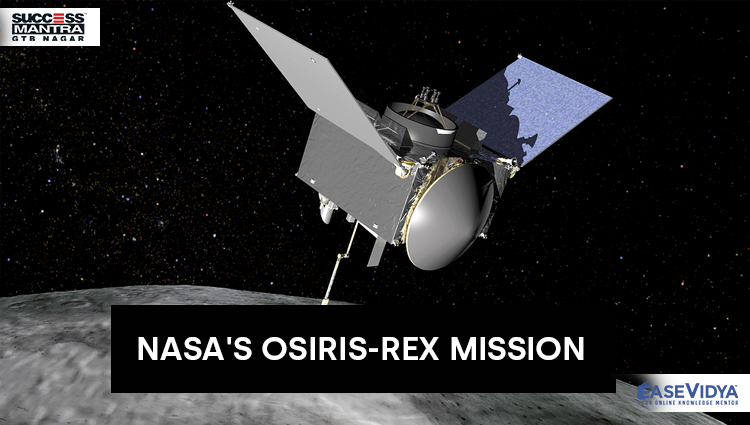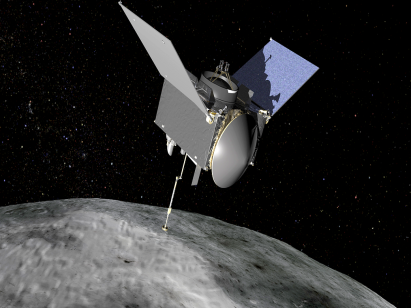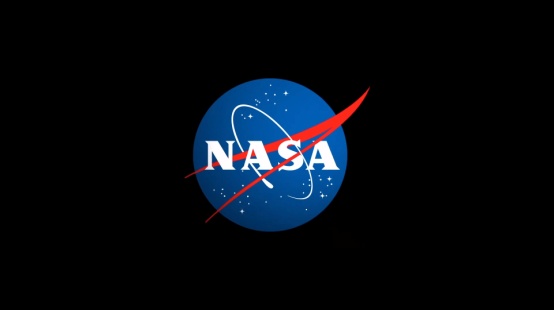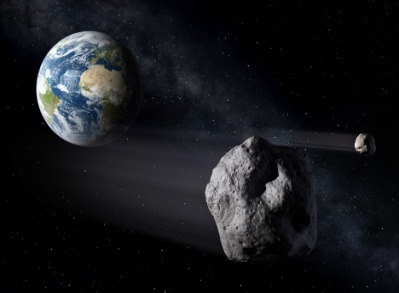
NASA OSIRIS REX MISSION
NASA'S OSIRIS-REX MISSION

Recently, NASA’s OSIRIS-REx spacecraft departed from asteroid Bennu, and started its two-year long journey back to Earth. OSIRIS-REx is NASA’s first mission to visit a near-Earth asteroid, survey its surface and collect a sample from it.
ABOUT OSIRIS-REX MISSION
It is the United States’ first asteroid sample return mission, aiming to collect and carry a pristine, unaltered sample from an asteroid back to earth for scientific study. The OSIRIS-REx (Origins, Spectral Interpretation, Resource Identification, Security, Regolith Explorer) spacecraft was launched in 2016 for the journey to Bennu. The mission is essentially a seven-year-long voyage and will conclude when at least 60 grams of samples are delivered back to the Earth (in 2023). As per the National Aeronautics and Space Administration (NASA), the mission promises to bring the largest amount of extraterrestrial material back to the Earth since the Apollo era. Apollo was the NASA program that resulted in American astronauts’ making a total of 11 space flights and walking on the moon (1968-72). The spacecraft contains five instruments meant to explore Bennu including cameras, a spectrometer and a laser altimeter. Recently, the spacecraft’s robotic arm called the Touch-And-Go Sample Acquisition Mechanism (TAGSAM), made an attempt to “TAG” the asteroid at a sample site and collected a sample.
SIGNIFICANCE OF THE MISSION
Scientists will use the asteroid samples to study the formation of the solar system and of habitable planets such as Earth. NASA will also distribute a part of the samples to laboratories worldwide and will reserve about 75% of the samples for future generations who can study it with technologies not yet created.
Asteroid Bennu: Bennu is an ancient asteroid, currently more than 200 million miles from Earth. It is about as tall as the Empire State Building (US) and is named after an Egyptian deity. The asteroid was discovered by a team from the NASA-funded Lincoln Near-Earth Asteroid Research team in 1999. It is known that this asteroid is a B-type asteroid, implying that it contains significant amounts of carbon and various other minerals. Because of its high carbon content, it reflects about 4% of the light that hits it, which is very low when compared with a planet like Venus, which reflects about 65% of the light that hits it. Earth reflects about 30%. Around 20-40% of Bennu’s interior is empty space and scientists believe that it was formed in the first 10 million years of the solar system’s formation, implying that it is roughly 4.5 billion years old. There is a slight possibility that Bennu, which is classified as a Near Earth Object (NEO), might strike the Earth in the next century, between the years 2175 and 2199. NEOs are comets and asteroids nudged by the gravitational attraction of nearby planets into orbits which allows them to enter the Earth’s neighbourhood. Bennu is believed to have been born in the Main Asteroid belt between Mars and Jupiter and because of gravitational tugs from other celestial objects and the slight push asteroids get when they release absorbed sunlight, the asteroid is coming closer to Earth. Bennu offers scientists a window into the early solar system as it was first taking shape billions of years ago and tossing ingredients that could have helped seed life on Earth. Significantly, Bennu hasn’t undergone drastic changes since its formation over billions of years ago and therefore it contains chemicals and rocks dating back to the birth of the solar system. It is also relatively close to the Earth.
NATIONAL AERONAUTICS & SPACE ADMINISTRATION (NASA)

The National Aeronautics and Space Administration (NASA) is an independent agency of the executive branch of the United States federal government responsible for the civilian space program, as well as aeronautics and aerospace research. Established under the National Aeronautics and Space Act 1958. Headquarters: Washington, DC, USA
History: Following World War II, the United States was in direct competition with the erstwhile Soviet Union (the superpower that was disbanded into several sovereign nations including the Russian Federation, Kazakhstan, the Ukraine, etc. in 1991). That period was called “Cold War”. It was the Soviet Union’s launch of Sputnik on October 4, 1957, that first put an object into orbit around Earth. It was followed in November by the even larger Sputnik II, which carried the dog Laika. Only in late January 1958, the United States could launch Explorer 1, hoisted aloft by the Army’s rocket team, using rocket technology developed from World War II. Though a small spacecraft weighing only 30 pounds, it discovered what are now known as the Van Allen radiation belts, named for the University of Iowa scientist Dr. James Van Allen, launching the new discipline of space science. Explorer 1 was followed in March, 1958 by the Navy’s Vanguard 1, 6 inches in diameter and weighing only 3 pounds. NASA’s birth was directly related to the launch of the Sputniks and the ensuing race to demonstrate technological superiority in space. Driven by the competition of the Cold War, on July 29, 1958, President Dwight D. Eisenhower signed the National Aeronautics and Space Act, providing for research into the problems of flight within Earth’s atmosphere and in space.
WHAT ARE THE ASTEROIDS?

These are rocky objects that orbit the Sun, much smaller than planets. They are also called minor planets. According to NASA, 9,94,383 is the count of known asteroids, the remnants from the formation of the solar system over 4.6 billion years ago.
Asteroids are divided into three classes: First, those found in the main asteroid belt between Mars and Jupiter, which is estimated to contain somewhere between 1.1-1.9 million asteroids. The second group is that of trojans, which are asteroids that share an orbit with a larger planet. The third classification is Near-Earth Asteroids (NEA), which have orbits that pass close by the Earth. Those that cross the Earth’s orbit are called Earth-crossers. More than 10,000 such asteroids are known, out of which over 1,400 are classified as Potentially Hazardous Asteroids (PHAs). PHAs are currently defined based on parameters that measure the asteroid’s potential to make threatening close approaches to the Earth.
Specifically, all asteroids with an Earth Minimum Orbit Intersection Distance (MOID) of 0.05 au or less and an absolute magnitude (H) of 22.0 or less are considered PHAs.
TEST YOURSELF
Q.1 NASA has launched the OSIRIS-REx (Origins, Spectral Interpretation, Resource Identification, Security, Regolith Explorer) spacecraft for journey to which of the following Asteroids?
- Asteroid 'Apophis'
- Asteroid 'Bennu': ANSWER
- Asteroid 'Astraea'
- None of the following
Q.2 Consider the following statements & state which of the following is/are incorrect in the reference to the OSIRIS-REx mission?
- The OSIRIS-REx (Origins, Spectral Interpretation, Resource Identification, Security, Regolith Explorer) spacecraft was a joint venture of NASA & CNES was launched in 2019 for the journey to Bennu.
- It is the United States’ first asteroid sample return mission, aiming to collect and carry a pristine, unaltered sample from an asteroid back to earth for scientific study.
- Only I follows: ANSWER
- Only II follows
- Both I & II follows
- None of the above
Q.3 Consider the following and mark which of the following is matched incorrectly
- Roscosmos State Corporation for Space Activities: Russia
- Defence Research and Development Organisation: India
- Space Exploration Technologies Corp: France
- None of the above
Q.4 Which of the following given statements is/are incorrect in the context of National Aeronautics Space Administration (NASA)?
- National Aeronautics and Space Administration (NASA) is an independent agency of the executive branch of the United States federal government
- National Aeronautical Space Administration (NASA) was established under the National Aeronautics and Space Act 1958.
- President John F. Kennedy (signed the National Aeronautics and Space Act, providing for research into the problems of flight within Earth’s atmosphere and in space: ANSWER
- None of the above
Q.5 NISAR is a joint project between which of the following two space agencies to co-develop and launch a dual-frequency synthetic aperture radar on an Earth observation satellite?
- NASA & DRDO
- CNES & ISRO
- CNES & NASA
- NASA & ISRO: ANSWER












FiveM Mlo
https://www.fivemmlo.net/ FiveM MLO (Multi-Level Object) is a custom object that can be add to a Fivem server. They are designe to be fully interactive with the game environment, allowing player to interact with objects in ways that would not be. At our FiveM MLO store, we are committe to providing the highest quality and most immersive MLOs for your server. Here’s why you should choose us. Buying Fivem MLOs enhances your gaming experience by providing unique, customize maps, houses, and interiors, adding immersive and exclusive elements to your Fivem server.